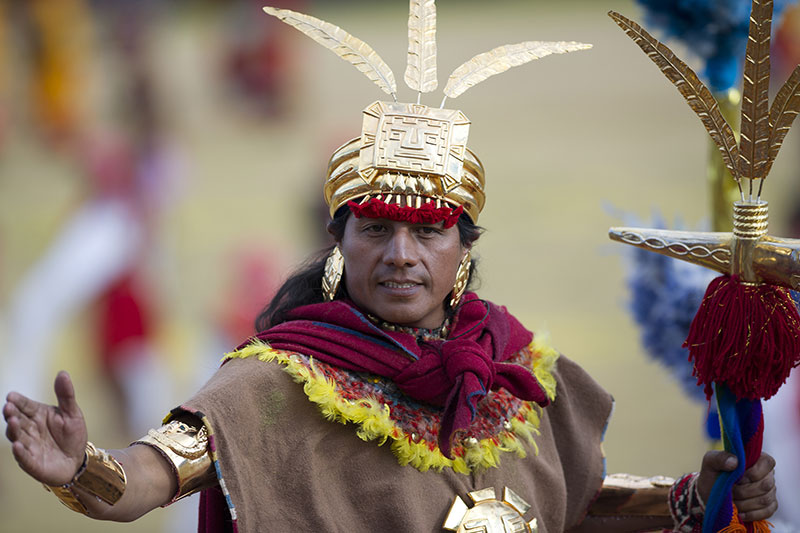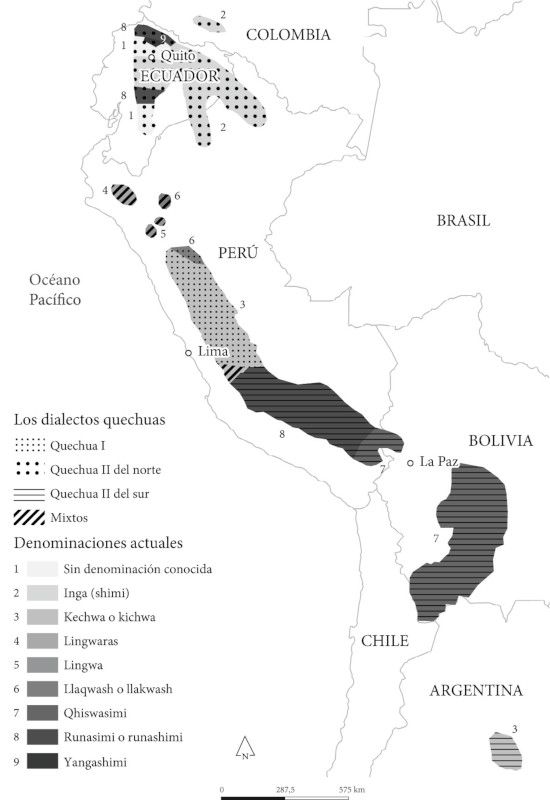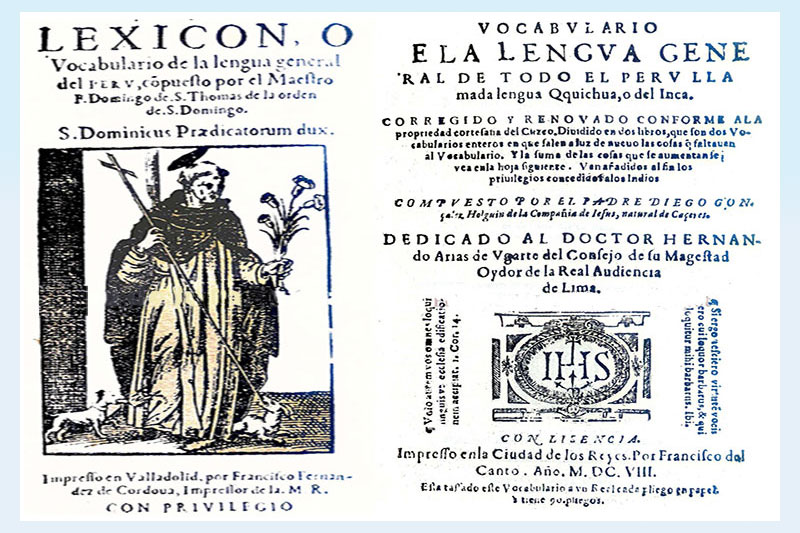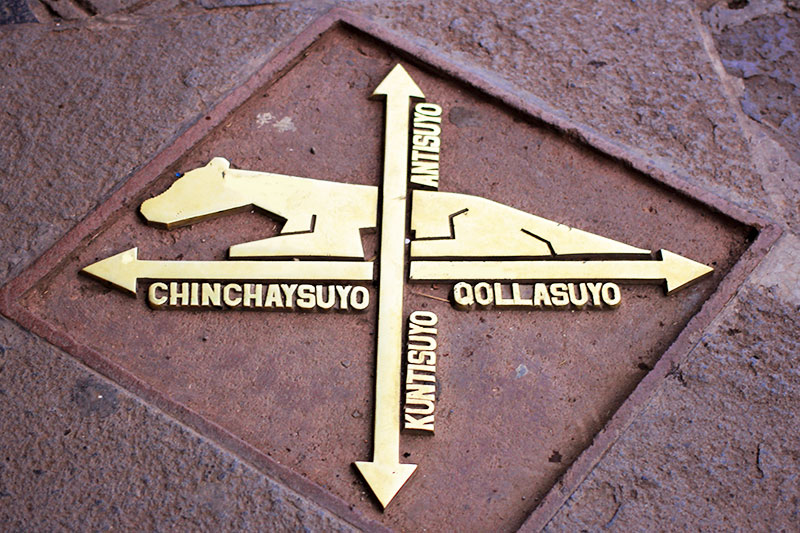Quechua, language of the Incas
Quechua, also called ‘Runa simi’ is the most widely used native language in South America. It is spoken in various regions of Peru, Bolivia, Ecuador, Colombia, Chile and Argentina. It has several dialects and divisions. It was the language of the Incas, who spread it throughout the Tahuantinsuyo empire. There are almost 12 million Quechua-speaking people on the continent. Contrary to what many people think, this language, far from disappearing, made new roots. It is currently one of the official languages of Peru.
- What is the origin of Quechua?
- Quechua and the Incas
- Map of the Quechua language today
- History of the Quechua language
- Are there books written in Quechua?
- How many people speak Quechua?
- Quechua on the trip to Cusco and Machu Picchu
- Some characteristics of Quechua
- Learn some words in Quechua

Representation of the Inca
What is the origin of Quechua?
- The ‘Runa simi’ or Quechua is born on the central coast of the Lima region. Spreading from there to Cusco and the entire Sacred Valley of the Incas, expanding to the south-east territory together with the empire of the Incas . The victors imposed their language as a unifying force, thus emerging the language of the state.
- The term “Runa simi” was changed to “Kichua” or “Quechua” in the work “Art and vocabulary of the general language of Peru called Quichua”, written by Fray Domingo de Santo Tomás in the 16th century.
Quechua and the Incas
- According to the legend of the origin of the Incas, these come from the Altiplano. The first Incas who arrived in Cusco in the 13th century did not speak Quechua. They spoke ‘Puquina’, which was a native language of the many that were spoken in the towns that surrounded Lake Titicaca in the highlands, border of Peru and Bolivia. Upon arriving in Cusco, they adapted to the language spoken there, which was Quechua (which was already spoken in many Andean and coastal areas of Peru).
- During the expansionist period of the Inca empire (at the beginning of the 15th century), the Quechua language spread mainly in the highland and southern territory of the Tahuantinsuyo empire . In many parts of the north and the coast the ‘Runa simi’ was already spoken. Elsewhere, Quechua did not replace the aboriginal languages spoken such as Mochica or Cañari.
Map of the Quechua language today

Quechua language map
History of the Quechua language
Quechua in ancient Peru
- Quechua expands from the Caral culture in Lima to later expand to some ethnic groups such as Chavín, Lima, Moche Wari and Nazca; to the south, the K’anas, Chunpiwillkas, Qanchis, Ayarmakas and others.
- In the Cusco region, Quechua arrives with the Yauris, the Chunpiwillkas, and the Canchis . The Incas, upon arriving in Cusco, also adapt Quechua as their own language. Later, with the expansion of the Inca empire, this language was finally consolidated in the vast Inca territory.
Quechua during colonial times
- In the viceroyalty of Peru, Quechua continued to be the language most widely spoken by the people who were forced to learn Spanish.
- However, the Catholic missionaries used Quechua and other languages spoken in the empire of the Incas to impart the new religious doctrine in the new world.
- Religious manuals were written in the most important languages of the empire, such as Aymara, Mochica or Guaraní . Thus it was that the Spanish rapidly increased their power over the people of the empire.
Quechua in the 20th century
- During the mid-20th century, Quechua was declared the official language of Peru, Bolivia, and Ecuador . Education in this language is established in the places where it is spoken.
- Some of its varieties reduce the number of its speakers. However, according to various studies, more and more people speak this language, especially in urban areas.
- Up to nine different varieties are identified, the greatest diversity of which is in the northern sector of Peru and Ecuador.
Quechua today
- Quechua is currently spoken in western South America. It is, along with Spanish, the official language in countries such as Ecuador, Colombia, Bolivia, Peru, Chile, and Argentina.
- It is used in the Andean region, especially where indigenous communities settle, such as the San Pedro de Atacama region in Chile. While in Argentina, Quechua is widely spoken in the province of Santiago del Estero.
- Finally, in Peru, Bolivia and Ecuador is where there are more speakers. Quechua has become so popular with locals and strangers that it even has its own search engine on Google.
Many linguists agree that Quechua is one of the languages that best expresses moods, sweetness, tenderness, passion, anger, or disdain. For many Quechua speakers, it is very difficult to translate Quechua into other languages as much is lost during this process. Despite what many people think, Quechua continues to evolve. It is believed that every year more people learn the language of the Incas.
Are there books written in Quechua?
- It is said that Fray Domingo de Santo Tomás (Dominican friar), was the first missionary to learn the Quechua language. During his evangelizing work in Peru, he published the first two works in Quechua, “the grammar or art of the general language of the Indians of the kingdoms of Peru” and the “Lexicon” (vocabulary of the general language of Peru).
- In 1680, the so-called golden age of Quechua literature began (mainly in southern Peru). In this period the drama ‘Ollantay’ is written, originating from an oral tradition since the time of the Incas.
- After the defeat of Túpac Amaru II (1781), the use of native clothes and languages is prohibited, as well as any manifestation of customs or ways of life, different from those of the invaders. Causing the decline of the Andean elites and generating a social stigma against the language, but without making it disappear completely.

First Quechua Book “Lexicon” by Fray Domingo de Santo Tomás
How many people speak Quechua?
- Currently there are about 12 million people who speak Quechua. Peru is the country with the most Quechua speakers. The language of the Incas is also spoken in the north of Argentina, the southeast of Bolivia, Chile (in Alto and El Loa) as well as the southwest of Colombia and the northeast of Ecuador. It is the most widely spoken native language on the continent.
Quechua on the trip to Cusco and Machu Picchu
- Cusco, the ancient capital of the Inca empire, is one of the places in Peru with the most Quechua speakers. It is estimated that 45% of its population speaks this language. That is why the tourist, during their visit to Cusco and Machu Picchu, will have to come across a Quechua speaker at some point.
- However, in Cusco, many of the Quechua speakers are also fluent in Spanish as a second language. Some of them also know English. Therefore, tourists are recommended to know a little Spanish and, why not, Quechua for their visit to Cusco and Machu Picchu in Peru.
Some characteristics of Quechua
Quechua is quite an expressive language. It expresses trust, appreciation and affection These are some of its characteristics:
- Onomatopoeic: Quechua voices are born from natural noises, such as the sounds of the wind, the running of water, the chirping of birds, etc.
- Polysynthetic: It is said like this, since adding a morpheme or suffix to a lexeme or root word, other words are born.
- Polysemic: A large number of words in the Quechua language have two or more meanings
Learn some words in Quechua
Don’t miss the opportunity to learn some Quechua. You will be proud to know something of the language of the Incas, even if it is only a few words:
- Hello: Rimaykullayki or Napaykullayki.
- How are you ?: Allillanchu?
- Well. And you ?: Allillanmi, Qamrí?
- What is your name ?: Imataq sutiyki?
- My name is: Sutiymi kan…

The Quechua Language spread in the four Suyos
By Ticket Machu Picchu – Last updated, August 15, 2024